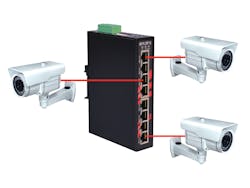Power over Ethernet: Video’s Best Friend
Today, Power over Ethernet (PoE) has become a hot term that is frequently referenced but not completely understood. There are a lot of different acronyms and subtle differences used in the PoE arena that can quickly confuse and frustrate even advanced users. Despite all of the naming rules and subtle confusion, PoE has been widely adopted due to the challenges it has overcome and simplicity it has provided. PoE in its basic function is quite simple, plug in an Ethernet cord and it can receive both communication as well as power to the PoE capable device.
PoE was first developed in 2000 by Cisco to reduce noise issues in emerging VoIP phone systems. It quickly took off — by 2003 the first PoE standard was developed to create uniformity among all PoE device manufacturers.
PoE is an improvement over standard Ethernet network communication because of the reduction in both the equipment needed and wired connections to the devices — why run both an Ethernet wire and a power cord to a unit when one Ethernet wire can work?
Naming Rules and Installation Considerations
PoE is used as an all-encompassing term for all devices within the PoE market; however, in actuality, PoE can be split into two broad categories: Power Sourcing Equipment (PSE) and Powered Devices (PD). The PSE is the main unit that injects the power into and along the Ethernet cord. It is typically a switch or power injector. PDs are end-devices that require power through the Ethernet cable to turn on, such as an IP camera, VoIP phone or outdoor industrial wireless access point.
When installing either a PSE or a PD, there are two important considerations: How the power is sent along the Ethernet wire; and how much power will be required.
There are two different standards of how the power is sent along the Ethernet wire — PoE mode A, which seems to include the majority of PoE devices, uses pins 1, 2, 3 and 6 to send power along the Ethernet cable; PoE mode B devices use pins 4, 5, 7 and 8 for power transmission.
PoE PSE sourcing units have multiple different power output levels: mainly standard power and high power — what is referred to as PoE+ — are used. The Institute of Electrical and Electronics Engineers (IEEE) has two different official categories for the power outputs of a PSE device. The IEEE 802.3af standard states that devices will not output more than 15.4 Watts of power out of each port. The PoE+ or IEEE 802.3at standard allows each port to provide an output power of up to 30 Watts per port.
Typically, if a manufacturer’s PoE PSE switch supports IEEE 802.3at high-power devices capable of up to 30 watts of power, the switch will also perform power auto negotiation — meaning it will detect how much power is required by the PD to operate and not provide excess power to a device that only requires 15 Watts or less.
The Benefits
A great benefit and use of PoE units is when a power source is not available at the end-location — such as the side or top of a building for a security camera or a Wi-Fi access point. Another benefit of PoE is apparent when installing multiple devices at a location, such as surveillance cameras, as a PoE switch and all of the cameras can all use a single power supply. This can reduce the installation cost because there will be a reduction in the amount of equipment as well as in the amount of power cables needed.
Keep in mind the power budget for the power supply that will be used — for example, if connecting three IEEE 802.3af cameras (15 Watts per camera) to a PSE switch, the output wattage of the power supply will need to be able to supply 45 Watts of power for the cameras plus the additional wattage required to power the switch.
Environmental Considerations
An additional consideration when selecting PSE switches or a power supply is the temperature of the environment in which the devices will be used. In extreme conditions, industrial-grade equipment is essential, and extended temperature range equipment is available.
Proper selection of industrial-grade equipment is particularly important when using PSE units for PoE applications. A PSE unit will receive additional thermal activity over non-PSE devices, because it generates additional heat by providing power to the PDs.
Power supplies have an optimal operating temperature range. In hot environments, the power supply will be affected by an operational output derating curve — which means the total output wattage of the unit will be reduced by a percentage depending on the ambient temperature of the environment. Be aware that ambient temperature can have a significant effect on the calculated power budget for a specific application — at the extreme end, the total power supplied can be reduced by as much as 60 percent. Thus, a higher-wattage unit might be required to provide adequate power.
Power and Bandwidth Management
Managed switches are capable of providing users with advanced features that can improve the management capabilities, performance, security and resilience of a network. The capabilities that a managed switch provides have been proven time and time again; thus, the managed switch is the workhorse of the network.
Standard features to enhance network performance provided by a managed switch are still relevant when using and implementing PoE devices. In fact, PoE switches with management capabilities provide even more features that can be critical in providing optimum network performance.
Other management features — such as Internet Group Management Protocol (IGMP) — are efficient in handling multicast traffic, such as PoE security camera monitoring, within a network. A typical unmanaged switch tries to send the camera data to all of the devices connected to it, creating unneeded broadcast traffic; however, an IGMP-capable managed switch is able to determine the most effective pathways to all of the devices on the network, and thus will only send the data to the units that require it. The improved flow of data reduces the amount of network traffic and improves bandwidth availability.
The benefits from implementing IGMP on managed switches only increases as a network size becomes larger.
Managed PoE switches include additional features that can provide information specifically for PoE end-devices. They include: Capability to set and view the exact power being supplied to each port; the ability to set power priority levels; and the ability to cycle power to specific ports, which can be done either manually through a web console or automatically with an auto-ping tool.
The auto-ping tool can be used to periodically ping an IP address associated to one of the ports of the managed switch. If there is not a response from the IP address after a certain number of attempts, then the managed switch will cycle power to the port. Being able to cycle the power to a specific port can be used to re-establish communication to a device that might have become unresponsive in a remote or hard to reach location.
Brian Roth is Product Marketing Engineer for Antaira Technologies, a provider of industrial network connectivity solutions. To request more info about the company, please visit www.securityinfowatch.com/10271760.



